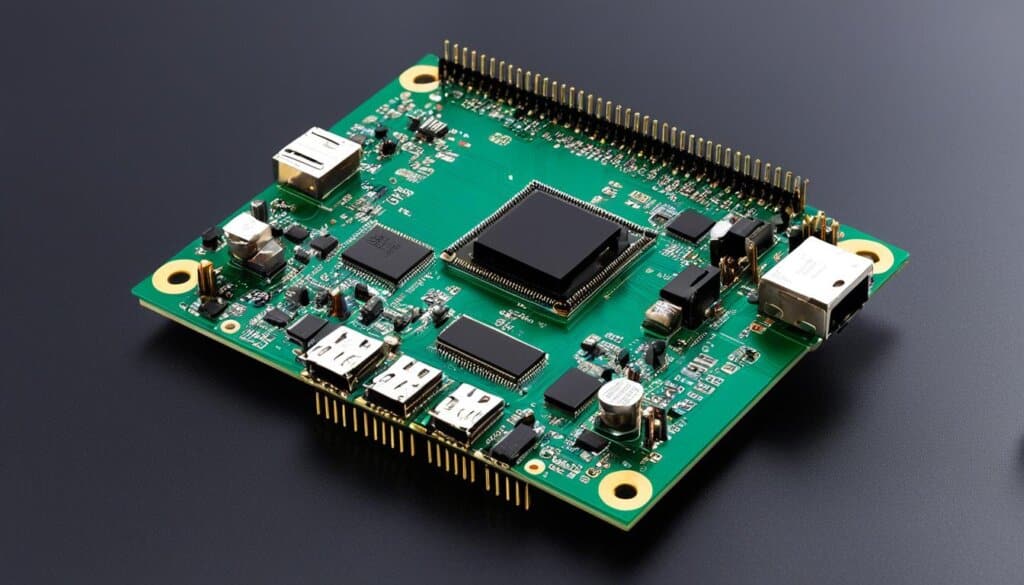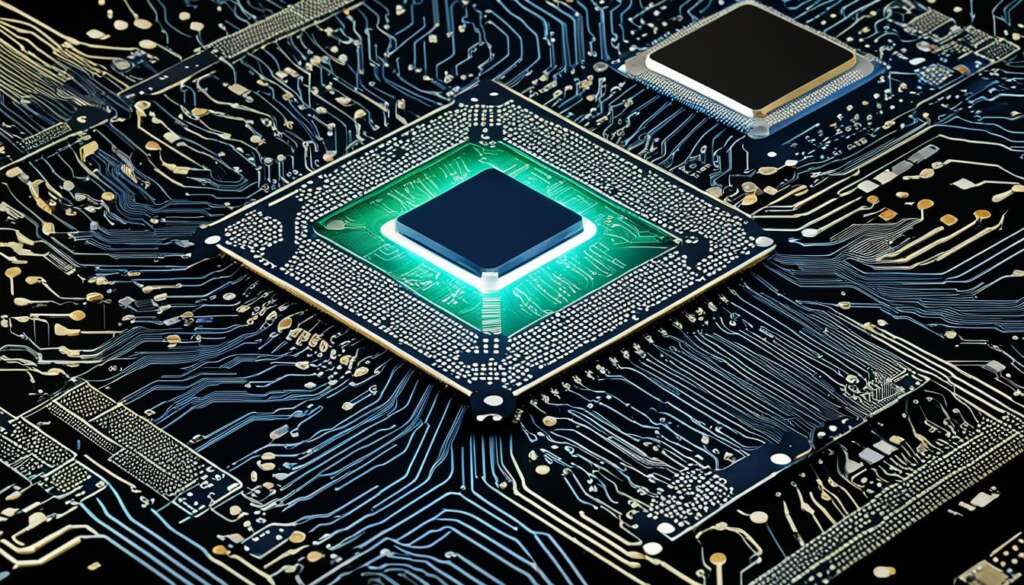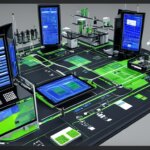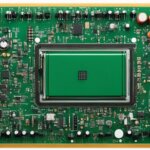Table of Contents
An embedded system is a combination of computer hardware and software designed for a specific function. It can be programmable or have a fixed functionality and is often a part of a larger system. Embedded systems are used in various industries such as automotive, consumer electronics, medical equipment, and industrial machines. They can range from devices with no user interface to those with complex graphical user interfaces. The embedded market is expected to be worth $116.2 billion by 2025, driven by investment in artificial intelligence, mobile computing, and high-level processing chips.
Examples of Embedded Systems
Embedded systems are used extensively in various industries and technologies. Let’s explore some examples of how embedded systems are utilized:
1. Automobiles
In the automotive industry, embedded systems play a crucial role in enhancing the safety, performance, and functionality of vehicles. These systems are responsible for various functions, including:
- Cruise control: Embedded systems enable automated speed regulation, enhancing the driving experience and fuel efficiency.
- Backup sensors: Embedded systems detect obstacles and provide alerts to prevent collisions while parking or reversing.
- Navigation systems: Embedded GPS systems provide real-time directions and guidance.
- Airbag systems: Embedded systems rapidly detect accidents and deploy airbags to protect passengers.
2. Mobile Phones
Modern mobile phones are equipped with numerous embedded systems that ensure their functionality and user experience. These embedded systems include:
- GUI software: Embedded graphical user interface software allows users to interact with the device.
- Operating systems: Embedded OS manages the phone’s resources, facilitating multitasking and app execution.
- Cameras: Embedded systems control image capture, focus, and various camera functionalities.
- Microphones: Embedded systems process audio input and support voice calls, voice recognition, and other audio-related features.
3. Industrial Machines
Industrial machines rely on embedded systems to monitor and control their operations, ensuring efficient and safe performance. Embedded systems used in industrial machines serve various purposes, including:
- Monitoring: Embedded systems collect and analyze data to monitor factors like temperature, pressure, and machine health.
- Control: Embedded systems regulate machine parameters to optimize performance and maintain safety standards.
4. Medical Equipment
Embedded systems play a critical role in the functioning of medical equipment, improving diagnostics, patient care, and treatment. Examples of embedded systems in medical equipment include:
- Sensing: Embedded systems utilize sensors for measuring vital signs, glucose levels, or other medical parameters.
- Control mechanisms: Embedded systems drive motorized components, regulate therapeutic devices, and enable accurate doses.
- User-friendly interfaces: Embedded systems provide intuitive interfaces for healthcare professionals and patients to interact with medical equipment.
These examples highlight the versatility and far-reaching impact of embedded systems in various industries. By seamlessly integrating hardware and software, embedded systems enable innovative functionalities and advancements in automobiles, mobile phones, industrial machines, and medical equipment.
How Embedded Systems Work
Embedded systems play a crucial role in the functioning of various mechanical and electrical devices. These systems are designed to be low-cost, low-power-consuming, and compact computers that are integrated into larger systems. They consist of essential components such as a processor, power supply, memory, and communication ports.
Communication protocols are used to facilitate data transmission between the processor and peripheral devices. The processor in an embedded system can either be a microprocessor or a microcontroller, with the latter being more commonly used. Microcontrollers, which are integrated circuits, offer the advantage of having peripheral interfaces and memory built-in.
One of the key features of embedded systems is their ability to operate in real-time environments. Real-time operating systems (RTOS) are employed to enable seamless communication between the hardware and software components, ensuring that tasks are executed with precise timing.
“Embedded systems function as an integral part of a complete device, performing specific functions and enhancing the overall performance of the device.”
To visually illustrate the concept of embedded systems, take a look at the diagram below:
Characteristics of Embedded Systems
Embedded systems are unique combinations of hardware, software, and firmware designed to perform specific tasks within a larger system. These systems can be either microprocessor-based or microcontroller-based, with microcontrollers being integrated circuits that include peripheral interfaces and memory.
Embedded systems are employed in various applications such as sensing, real-time computing, and Internet of Things (IoT) devices. Their functionality and complexity vary depending on the specific task they are designed for, which influences the choice of software, firmware, and hardware.
“Embedded systems are powerful computing systems that rely on small, lightweight microprocessors or microcontrollers to perform specialized tasks within a larger system.”
Hardware
The hardware component of an embedded system consists of the physical components that make up the system. This includes the microprocessor or microcontroller, memory, power supply, communication ports, and any additional peripheral devices. The hardware is responsible for executing the instructions provided by the software and interacting with the external environment.
Software
The software in an embedded system, also known as firmware, is responsible for controlling and coordinating the system’s operations. It is typically stored in non-volatile memory and designed to work efficiently with the system’s specific hardware. The software is written in high-level programming languages and often utilizes software development tools to simplify the programming process and ensure accuracy.
Firmware
Firmware refers to the permanent software programmed into read-only memory (ROM) or flash memory. It provides the low-level control and functionality required for the embedded system to perform its specialized tasks. Firmware is responsible for handling system initialization, managing hardware components, and ensuring smooth communication between the software and hardware.
Microprocessor-based vs Microcontroller-based
Embedded systems can be categorized as either microprocessor-based or microcontroller-based. Microprocessor-based systems utilize standalone microprocessors that primarily focus on processing data and executing instructions. They require additional components for memory and peripheral interfaces.
On the other hand, microcontroller-based systems integrate the microprocessor, memory, and peripheral interfaces onto a single integrated circuit. This integration makes microcontroller-based systems more cost-effective, compact, and power-efficient, making them ideal for applications where size, power consumption, and cost are critical factors.
Here’s a comparison table showcasing the main differences between microprocessor-based and microcontroller-based embedded systems:
| Criteria | Microprocessor-based | Microcontroller-based |
|---|---|---|
| Components | Microprocessor, separate memory and peripheral interfaces | Microcontroller integrates processor, memory, and peripheral interfaces |
| Size | Larger footprint due to separate components | Smaller footprint due to integration |
| Power Consumption | Higher power consumption | Lower power consumption |
| Cost | Typically higher cost due to additional components | Generally lower cost due to integration |
Embedded systems, whether microprocessor-based or microcontroller-based, are integral to modern technology and are widely used in various industries. Their versatility, compact size, and specialized functionality make them essential for powering devices and systems that we rely on in our daily lives.

Types of Embedded Systems
Embedded systems can be categorized based on their functional requirements and performance. They play a crucial role in various industries and sectors, enabling the efficient operation and control of devices and systems.
Mobile Embedded Systems
Mobile embedded systems are portable and small-sized devices that are widely used in our daily lives. These systems are designed to provide specific functionalities while being highly mobile and compact. Examples of mobile embedded systems include smartphones, digital cameras, smartwatches, and personal fitness trackers. These devices utilize embedded technology to perform tasks such as image processing, data storage, and communication.
Networked Embedded Systems
Networked embedded systems are connected to a network and communicate with other systems to provide essential functionalities. These systems enable seamless integration with other devices and allow for data exchange and collaboration. Examples of networked embedded systems can be found in home automation systems, smart security systems, and industrial control systems. They play a crucial role in creating interconnected ecosystems, enhancing efficiency, and enabling advanced monitoring and control capabilities.
Standalone Embedded Systems
Standalone embedded systems are self-contained devices that are not reliant on a host system. These systems are designed to perform specific tasks independently and are commonly found in various consumer electronics and appliances. Examples of standalone embedded systems include calculators, MP3 players, and digital thermostats. They are purpose-built devices that offer specialized functionalities without the need for external connections.
Real-time Embedded Systems
Real-time embedded systems are designed to provide timely and accurate responses within predefined time constraints. These systems are commonly used in critical applications where real-time performance is crucial, such as medical devices, industrial automation, and avionic systems. Real-time embedded systems ensure that critical tasks are executed within specific time intervals, enabling precise control and monitoring.
Performance-based Categorization
In addition to the functional categorization, embedded systems can also be classified based on their performance requirements. These classifications include small-scale, medium-scale, and sophisticated-scale embedded systems. These categories reflect the complexity and capabilities of embedded systems, catering to different application scenarios and industry needs.
| Embedded System Category | Description |
|---|---|
| Small-scale Embedded Systems | These systems are characterized by simple functionalities and limited complexity. They are commonly used in basic consumer electronics and appliances. |
| Medium-scale Embedded Systems | These systems offer moderate complexity and perform tasks that require a higher degree of processing power and connectivity. They are commonly found in automotive applications, home automation, and industrial control systems. |
| Sophisticated-scale Embedded Systems | These systems are highly complex and provide advanced functionalities and capabilities. They are used in applications that require extensive processing power, advanced connectivity, and real-time performance. Examples include high-end medical devices, aerospace systems, and robotics. |
Understanding the different types of embedded systems helps identify their specific applications and functionalities. Whether it is a mobile embedded system for on-the-go convenience or a real-time embedded system for critical operations, these systems play a crucial role in powering the modern world’s technological advancements.
Embedded Systems Design and Future Trends
Embedded systems are crucial components of various industries, and their design relies on the utilization of microcontrollers or microprocessors. While both options have their merits, microcontrollers are frequently preferred due to their integrated components that simplify the design process. These small-scale computers store software, known as firmware, on non-volatile memory. Typically, firmware is written using high-level programming languages, enabling developers to create efficient and reliable embedded systems.
To streamline the process and ensure accuracy, software development tools are widely employed in the creation of embedded systems. These tools provide developers with a range of functionalities, such as debugging, testing, and simulation, which significantly enhance the efficiency and productivity of the software development process. Through the utilization of these tools, developers can more effectively meet the demands of the rapidly evolving embedded systems industry.
The embedded systems industry is poised for substantial growth in the coming years, propelled by technological advancements in artificial intelligence (AI), virtual reality (VR), augmented reality (AR), machine learning, deep learning, and the Internet of Things (IoT). In 2017, the market for embedded systems was valued at $68.9 billion, and it is projected to reach $105.7 billion by 2025. As these technologies continue to advance and integrate into various sectors, the demand for innovative and sophisticated embedded systems will drive industry growth.
FAQ
What is an embedded system?
An embedded system is a combination of computer hardware and software designed for a specific function. It can be programmable or have a fixed functionality and is often a part of a larger system.
In which industries are embedded systems used?
Embedded systems are used in various industries such as automotive, consumer electronics, medical equipment, and industrial machines.
What are some examples of embedded systems?
Examples of embedded systems include functions in automobiles like cruise control and airbag systems, mobile phone components like GUI software and cameras, embedded systems in industrial machines for monitoring and control purposes, and embedded systems in medical equipment for sensing and user-friendly interfaces.
How do embedded systems work?
Embedded systems function as part of a complete device and are embedded in other mechanical or electrical systems. They are low-cost, low-power-consuming, small computers that include a processor, power supply, memory, and communication ports. They use communication protocols to transmit data between the processor and peripheral devices. Embedded systems often operate in real-time environments and use real-time operating systems (RTOS) to communicate with the hardware.
What are the characteristics of embedded systems?
Embedded systems typically consist of hardware, software, and firmware. They can be microprocessor-based or microcontroller-based. Microcontrollers are integrated circuits that include peripheral interfaces and memory. Embedded systems are often used for sensing, real-time computing, and IoT devices.
What are the different types of embedded systems?
Embedded systems can be categorized based on their functional requirements and performance. There are mobile embedded systems, networked embedded systems, standalone embedded systems, and real-time embedded systems, each serving different purposes in various sectors.
How are embedded systems designed and what are the future trends?
Embedded systems are designed using microcontrollers or microprocessors, with microcontrollers being more commonly used due to their integrated components. The software for embedded systems, also known as firmware, is stored on non-volatile memory and is typically written in high-level programming languages. Software development tools are often used to simplify the process and ensure accuracy. The embedded systems industry is expected to continue growing rapidly, driven by advancements in AI, VR, AR, machine learning, deep learning, and IoT.












